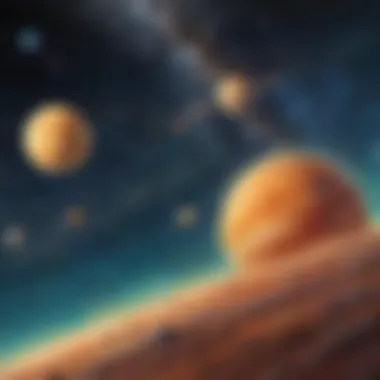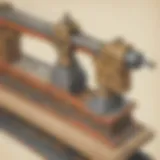Engaging Science Experiments for Fourth Graders


Intro
In the realm of education, the importance of engaging young minds cannot be overstated. Children in the fourth grade possess a natural curiosity about the world around them. Their cognitive abilities have developed enough for them to explore basic scientific concepts while still craving hands-on activities. This article focuses on simple science experiments designed specifically for children in this age group.
The experiments featured here require minimal materials—often just common household items—and foster a practical approach to learning. By conducting these experiments, kids can grasp essential scientific principles while having fun. This resource caters to teachers, parents, and caregivers who aim to nurture a love for science through engaging and accessible means.
Science Fun Facts
Learning can be more enjoyable when sprinkled with interesting facts about science. Let’s discover some captivating trivia and stories that can intrigue young learners.
Interesting Trivia and Facts
- Water can exist in three states: solid, liquid, and gas. This phenomenon takes place naturally in the environment.
- The heart of an average elementary school child beats about 80 to 120 times per minute.
- Bananas are naturally radioactive due to the presence of potassium-40, an isotope of potassium.
Quirky Science Stories
Did you know that a scientist accidentally discovered the first non-stick coating while trying to create a gas for refrigeration? This coating, known now as Teflon, became widely used in cookware. Such stories can capture imaginations!
Amazing Science Records
- The tallest volcano in the world is Ojos del Salado, located in Chile at over 6,900 meters.
- The largest living organism is a mushroom in Oregon that covers over 2,385 acres!
Thought-Provoking Questions
Encouraging children to think deeper is vital. Here are some questions that can spur discussions:
- Why does ice float on water?
- How do plants grow without visible eyes to watch the sun?
Discover the Wonders of Science
Science is all around us, ready to be explored. Each experiment can provide a unique understanding of scientific concepts and the world.
Exploring Various Scientific Concepts
Children can engage with topics like chemical reactions, ecosystems, and physics through hands-on experiments. The practical nature of these activities connects classroom learning with real-life instances.
Educational Videos and Animations
Visual learning aids can enhance understanding. Platforms like YouTube offer numerous educational resources. Kids can watch explanations of scientific phenomena, making difficult concepts easier to grasp.
Interactive Learning Tools
There are many tools available for interactive learning, such as virtual labs and science apps. These tools can make the learning process immersive and fun.
Real-Life Applications of Science
Children should understand how science affects their everyday life. Discussing topics like weather patterns or basic engineering can help bridge theories with practical applications.
Science Experiment Showcase
Having access to fun experiments encourages parents and teachers to facilitate learning effectively. Below are some highlighted experiments suited for fourth graders.
Fun and Engaging Experiments
Here are a few experiments that can capture children's interest:
- Volcano Eruption: Creating a small volcano using vinegar and baking soda.
- Grow Crystals: Using sugar or salt to form crystals over time.
Step-by-Step Instructions for Volcano Eruption
- Create a mound from clay or playdough, leaving space at the top for your baking soda.
- Add baking soda into the cavity.
- Pour vinegar mixed with food coloring into the volcano.
- Watch it erupt!
Materials List
- Vinegar
- Baking soda
- Food coloring (optional)
- Clay or playdough
Safety Tips and Precautions
Always ensure adult supervision during experiments to ensure safety. If any irritation occurs with materials used, rinse thoroughly and consult an adult.
Science encourages exploration. Each experiment opens a door to new knowledge and a deeper understanding of the world.
By engaging in these activities and discussions, children can develop a lasting curiosity about the sciences. This curiosity is an essential component for fostering future academic interest.
Preamble to Science Experiments for Young Learners
In today’s educational environment, engaging young learners in science through hands-on experiments is crucial. Fourth graders, typically aged nine to ten, are at a stage where they begin to think critically and ask questions about the world around them. This article aims to illuminate the importance of practical scientific exploration for these young minds.


Hands-on learning stimulates curiosity and encourages students to actively participate in their education. It allows children to practice scientific methods, such as observation, hypothesis formation, and experimentation. By involving them in real-world applications of science, we nurture their ability to analyze and solve problems. The benefits of practical science experiments extend beyond academic performance; they promote teamwork, patience, and perseverance, essential skills for any endeavor in life.
Therefore, it is imperative to set the stage for exploration. In the following sections, we will discuss the significance of engaging activities and how they foster a love for science, paving the way for a future populated with innovative thinkers and problem solvers.
The Importance of Hands-On Learning
Hands-on learning is a dynamic process that encourages actively engaging with materials rather than passively receiving information. Fourth graders thrive in this environment as they can manipulate objects, make observations, and physically see the results of their actions. This type of learning can lead to deeper understanding and retention of knowledge. Research shows that students who engage in hands-on activities outperform those who do not, particularly in grasping complex concepts.
When students conduct experiments, they often work in groups, enhancing their communication and collaboration skills. They learn from each other, and discussions can lead to greater insights than they might achieve alone. Moreover, this method of learning is generally more enjoyable, which helps combat the common issue of disengagement found in traditional learning settings.
Setting the Stage for Exploration
Creating an environment conducive to exploration is key to fostering a positive scientific experience. Begin by ensuring a well-organized, safe space filled with accessible materials. A designated area with ample supplies allows children to explore at their own pace without the frustration of acquiring materials each time they want to experiment. Items found around the home can be transformed into tools for scientific discovery.
Furthermore, encourage an open-minded approach to inquiry. Present challenges and questions that stimulate curiosity, allowing students to express their own ideas and hypotheses. Create opportunities for them to design their own experiments, cultivating a sense of ownership over their learning process.
Engagement can significantly increase when children feel their ideas are valued. This prepares them not only for immediate tasks but also for future experiences in science and beyond.
"Engaging students in hands-on experiments empowers them to take charge of their own learning and fosters a lifelong love for science."
In summary, establishing a robust framework for hands-on science education will lay the groundwork for an enriching learning experience for fourth graders. It provides avenues for exploration, research, and a fundamental understanding of scientific principles.
Safety Guidelines for Young Scientists
The safety of young learners during science experiments is critical. Ensuring a safe environment not only helps prevent accidents but also builds a sense of responsibility. Fourth graders are at an age where they are eager to explore but may not fully understand potential hazards. By establishing clear safety guidelines, we prepare them to engage in scientific exploration with care and awareness.
Key Elements of Safety Guidelines:
- Awareness of Hazards: Children need to be educated about the materials they are using. This includes understanding the difference between safe and harmful substances.
- Proper Handling of Equipment: Teaching kids how to use tools and instruments correctly is essential. Demonstrating safe handling reduces the risk of injury.
- Clean-up Procedures: Knowing how to clean workspaces after experiments prevents accidents and teaches responsibility.
Overall, providing safety guidelines fosters an atmosphere where children are free to learn and explore without fear of injury. It helps develop a culture of safety that is indispensable in any scientific setting.
Understanding Scientific Safety
Understanding scientific safety is fundamental before embarking on any experiment. First, it is vital for both adults and children to recognize potential dangers in their activities. Some common safety rules include:
- Wearing Protective Gear: Always have safety goggles and gloves when necessary.
- Avoiding Ingestion: Children must be taught not to touch their face or mouth before washing their hands after experiments.
- Working in a Well-Ventilated Area: Some experiments may release fumes. Ensuring proper airflow is crucial.
In addition to these rules, explaining the reasoning behind them helps instill a sense of caution and responsibility in children. When they understand why safety matters, they are more likely to remember these practices.
Choosing Appropriate Supervision
Deciding who will supervise the experiments is an important aspect of planning. Proper supervision ensures safety and promotes an engaging learning experience. Adults, whether parents, teachers, or guardians, should be actively involved while younger scientists explore their interests. Here are some points to consider when choosing supervision:
- Competence in Science: The supervisor should have a basic understanding of scientific principles related to the experiments. This ensures they can guide effectively.
- Approachability: Children benefit from a supervisor who encourages questions and discussion. An approachable adult fosters a nurturing atmosphere for curiosity.
- Availability: Supervision should be more than just watching. Engaging with students during the experimentation process ensures that potential risks are managed and learning opportunities are maximized.
"Safety is not just the absence of danger; it is an essential part of the learning process."
By keeping these factors in mind, parents and educators can provide a safe and productive environment for young scientists to flourish.
Simple Chemistry Experiments
Simple chemistry experiments play a crucial role in introducing young learners to the fundamentals of science. These activities engage students by demonstrating the principles of chemistry through hands-on learning. When fourth graders participate in these experiments, they not only learn about chemical reactions but also develop critical thinking and observational skills. The accessibility of the materials used makes these experiments inviting, ensuring that children can successfully complete them with minimal resources. This approach fosters an environment conducive to exploration and inquiry.
Creating a Volcano Eruption
Materials Needed
The materials required for the volcano eruption experiment are simple and often found in many homes. Key items like baking soda, vinegar, and food coloring can easily be sourced. This accessibility contributes to the experiment's popularity among educators and parents. Each ingredient serves a specific purpose, making it a beneficial choice for engaging young learners. For example, baking soda is a common household ingredient, reducing barriers for participation. However, while these materials are easy to obtain, supervision is recommended, especially regarding the use of vinegar to ensure safety.
Step-by-Step Instructions
The step-by-step instructions outline how to create the volcano eruption, clearly and precisely. This simplicity is a critical characteristic, as it allows fourth graders to follow along with ease. The instructions should guide students through each phase of the process, such as mixing the ingredients and observing the reaction. Having a well-structured set of instructions can make the experiment both successful and enjoyable. However, if the steps are too complex, children might lose interest or become confused, so clarity is essential.
Scientific Explanation
The scientific explanation behind the volcano eruption gives context to the experiment. It highlights the chemical reaction between baking soda and vinegar. Understanding this reaction not only satisfies curiosity but also reinforces fundamental chemistry concepts. The explanation should be simplified for the audience while retaining accuracy. This balance can enhance learning by connecting the excitement of the experiment with scientific principles. Without this foundation, the experiment may seem like mere entertainment rather than a learning opportunity, which limits its educational impact.
Making Homemade Slime
Ingredients Required
The ingredients for making homemade slime are straightforward and safe for children. Basic components like white glue, borax, and water are easy to find, making this experiment attractive. Each ingredient plays a role in property changes that are educational. For instance, glue serves as a polymer base, introducing young minds to complex concepts in a simplified manner. The familiarity of these components can enhance comfort levels among children, encouraging them to participate. However, parents should monitor the use of borax due to its potential hazards when ingested.
Preparation Method
Preparing the slime requires following a clear method, which is accessible for young learners. Each step should be detailed, describing how to combine ingredients and when to knead the mixture. This method allows children to witness transformations firsthand, illustrating fundamental chemistry concepts in action. The straightforward preparation makes it easy for both teachers and parents to facilitate this experiment, thus removing some pressure on the educator. Still, adequate supervision is necessary to manage any potential mess during the process.


Why It Works
Understanding why homemade slime works offers valuable science lessons about polymers. The experiment illustrates how combining glue and borax creates a new substance with unique properties. Recognizing this process is vital for grasping basic scientific concepts and cultivating analytical skills. Linking the experiment to everyday materials enhances relatability, allowing children to see the relevance of science in their lives. Ignoring the 'why' risks presenting the experiment solely as a fun activity rather than an insightful educational experience.
Engaging Physics Experiments
Engaging physics experiments are essential for fourth graders. They help children uncover the principles of physics through practical activities. By engaging in these experiments, kids improve their understanding of concepts like force and motion, which are foundational in science. These activities not only stimulate curiosity but also enhance critical thinking skills. Moreover, they provide tangible results that children can observe, which reinforces their learning experience.
Balloon-Powered Cars
Components for Construction
For balloon-powered cars, several components are necessary. Key parts include a balloon, a plastic straw, wheels, and a base. Each item contributes to the functionality of the car. A balloon serves as the engine, while the straw acts as a nozzle, controlling the flow of air. Wheels can be made from bottle caps or any round object to support movement. Using simple materials keeps costs low and encourages creativity. This simplicity makes balloon-powered cars a favorite choice for hands-on learning in this article.
Building Steps
Building steps for creating balloon-powered cars are straightforward, making them accessible for young learners. First, children attach wheels to the base. Then, they insert the straw into the balloon, ensuring it's sealed well. Finally, the balloon is inflated, and when released, it drives the car forward. These clear, easy-to-follow steps are perfect for elementary students looking to experiment with physics principles. This methodical approach also enhances their ability to follow instructions.
Concept of Force and Motion
The concept of force and motion is vital in understanding how balloon-powered cars work. When the air rushes out of the balloon, it pushes the car forward. This illustrates Newton's third law of motion: for every action, there is an equal and opposite reaction. Highlighting this principle is beneficial because it connects theory to practice. Students grasp how forces interact and apply to real-world scenarios, leading to deeper comprehension of physics concepts.
Building a Simple Catapult
Necessary Materials
Making a simple catapult requires few materials: popsicle sticks, rubber bands, and a small cup. Each of these components plays an important role. Popsicle sticks form the structure, while rubber bands provide the launching mechanism. The cup is essential for holding objects to be launched. This selection of materials is popular because it is inexpensive and readily available, making it easy for teachers and parents to gather.
Assembly Instructions
Assembly instructions for the catapult are concise and easily understood. First, stack several popsicle sticks and secure them with rubber bands. Then, create the launching arm by attaching another popsicle stick and a cup at one end. Lastly, secure the other end with rubber bands to allow it to pivot. These instructions promote logic in building, enabling kids to visualize how structures work. Following these steps helps reinforce their ability to construct simple machines.
Energy Transfer Explanation
Understanding energy transfer is crucial in the operation of the catapult. When the launching arm is pulled back, potential energy builds up in the rubber bands. Releasing it converts this potential energy into kinetic energy, launching the object in the cup. This explanation is powerful as it illustrates basic principles of physics in action. It reinforces critical ideas about energy transformations, providing students with a framework for further exploration in physics.
Life Science and Biology Experiments
Life Science and Biology Experiments are essential in understanding the natural world. For fourth graders, these experiments provide an engaging way to learn basic biological concepts. They explore the intricate relationships between living organisms and their environments. Kids develop observational skills, fostering curiosity about nature. This engagement ignites a passion for science, vital for holistic education. Plus, children appreciate life sciences' relevance in their daily lives.
Exploring Plant Growth
Items Required
The items required for exploring plant growth include simple materials that are easy to find at home or school. Seeds, potting soil, containers, and water are the primary supplies. These materials are practical because they offer a direct way for kids to connect with the life cycle of plants.
The key characteristic of using seeds is their accessibility. Most families have them for cooking or gardening, which makes them a popular choice. The unique feature of seeds is their ability to sprout and grow in various environments, showing adaptability. This aspect makes them a compelling choice for young scientists.
Planting Procedure
The planting procedure involves straightforward steps that can be easily followed. Children start by filling containers with soil, planting seeds, and watering them. This simple process encourages responsibility as kids monitor their plants' growth. It's beneficial since it promotes patience and dedication.
One notable aspect of this procedure is the sensory experience it offers. Kids can touch the soil, see the seeds, and observe changes day by day. However, some might find it challenging to keep the conditions right for growth, like ensuring proper sunlight and moisture.
Understanding Photosynthesis
Understanding photosynthesis is fundamental in biology. It explains how plants convert sunlight into energy, which is crucial for their growth. This concept is vital because it illustrates the energy cycle within ecosystems. Children learn that plants need sunlight, water, and carbon dioxide to produce oxygen and glucose.
The key characteristic of this topic is its simplicity yet profound implications. When children grasp photosynthesis, they connect with larger ecological themes. The unique feature lies in how this process impacts oxygen levels and food sources for animals, including humans. An advantage is that kids often find it fascinating to learn their actions, like planting and watering, contribute to this essential process.
Earth Science in Everyday Life
Understanding Earth Science is critical, especially for young learners. It encompasses various concepts that directly relate to the world surrounding us. Teaching fourth graders about Earth Science helps them recognize the importance of natural resources and the environment. Such knowledge fosters a sense of responsibility towards conservation and sustainability. Additionally, these experiments encourage inquiry-based learning, pushing students to ask questions and seek answers actively.
Engaging with Earth Science also connects science to daily activities. For example, students can explore weather patterns, the water cycle, and landforms through hands-on experiments. These real-world applications make the subject more relatable and enjoyable.
Creating a Water Cycle Model
Materials Needed
To create a water cycle model, certain materials are essential. You will need a clear plastic container, soil, small plants or grass seeds, water, and a lid. These materials should ideally be easily accessible, making this activity practical for home or classroom settings. The benefit of using common household items is that it lowers the barrier to participation.
The unique feature of these materials is their multifunctionality. For example, the clear plastic container allows students to observe the entire water cycle process. They can watch condensation forming and precipitation occurring, thus experiencing science visually. The ecological aspect included in this experiment shows the interconnectedness of elements in Earth Science.
Model Assembly Instructions
The assembly of the water cycle model is straightforward, promoting engagement. Begin by placing soil in the container and planting seeds or small plants. Slowly add water to saturate the soil, adhering to the right amount for optimal growth. After setting, seal the container with the lid to create a regulated environment.


This assembly process is beneficial as it requires systematic steps that teach precision and care. The transparent container also allows for ongoing observations, helping students track changes over time and understand essential concepts of the water cycle effectively.
Concept of the Water Cycle
The water cycle is a fundamental Earth Science concept that describes how water moves through various forms and stages. It includes evaporation, condensation, precipitation, and collection. Understanding this cycle is crucial for recognizing how weather and climate function, impacting ecosystems and communities.
The water cycle's unique feature is its cyclical nature. It emphasizes the constancy of water on Earth, reminding students that water is reused indefinitely, which is a vital aspect of resource management. This teaches young learners about sustainability and the importance of preserving our water sources.
Building a Simple Weather Station
Tools Required
To construct a simple weather station, you will need a few standard tools and materials like a thermometer, a rain gauge, and an anemometer, which can be created from plastic bottles or cups. This variety of tools aids in observing different weather conditions, which is vital for young learners to grasp the concept of meteorology at an early stage.
The advantage of these tools is their simplicity. They do not require foresight for complex understanding as they directly relate to observable weather phenomena. Students can easily use these tools to measure temperature, rainfall, and wind speed, which creates a personal connection to the weather.
Construction Steps
Building the weather station involves simple construction steps. Begin by assembling the rain gauge using a clear container, allowing children to see the collected rainfall. Next, set up the thermometer in a shaded area to measure air temperature. Finally, the anemometer can be constructed using lightweight cups attached to a stick, letting the wind show its speed.
These construction steps are straightforward enough for fourth graders while offering a hands-on approach that engages critical thinking. The task of building this weather station enhances their understanding of scientific measurements and data collection directly.
Understanding Meteorology
Meteorology is the science of studying the atmosphere and forecasting weather. For young learners, grasping the basics of meteorology is essential as it allows them to interpret weather forecasts and understand atmospheric conditions affecting their environment.
The key characteristic of meteorology is its direct impact on daily life. By understanding how weather patterns work, children gain insights into climate change and its implications. Furthermore, studying meteorology encourages critical thinking, as students learn to analyze data they collect from their weather station and make observations based on real conditions.
Engaging students with Earth Science through experiments like these fosters a deeper appreciation for their environment. By exploring the water cycle and building a weather station, children can link abstract scientific principles to palpable experiences in their everyday lives.
Integrating Technology in Experiments
Integrating technology in science experiments can greatly enhance the learning experience for fourth graders. Technology provides tools that can simplify complex concepts, make data collection efficient, and engage young learners more fully. Today, when children are comfortable with technology, it is crucial to include it in educational settings. By using technology, students can explore scientific principles more dynamically, allowing them to relate to real-world applications. The ease of access to information and the capability to perform experiments digitally can foster a love for science that extends beyond the classroom.
Using Apps for Data Collection
Using apps for data collection during experiments offers a multitude of benefits. Many free and user-friendly applications can help children record observations, track results, and analyze data in real time. For instance, apps like "Science Journal" by Google allow students to log their experiments and utilize the sensors in their devices to gather data. This transforms the learning process from passive observation to active participation.
- Benefits of Using Apps:
- Helps in organizing data
- Allows for instant feedback
- Makes data visualization easier
- Encourages analytical thinking
When selecting an app, consider its ease of use. It should be intuitive so that fourth graders can navigate it without assistance. Teachers and caregivers can encourage students to experiment with a variety of apps to find one that fits their needs. Moreover, using these apps in conjunction with traditional methods can create a comprehensive learning environment that suits different learning styles.
Engaging with Digital Science Tools
Digital science tools further engage students by providing interactive and visual ways to learn scientific concepts. Websites and online platforms like Khan Academy and PhET offer simulations that can be fantastic resources for understanding subjects like physics or chemistry.
- Key Features of Digital Tools:
- Interactive simulations
- Step-by-step guided experiments
- Access to additional resources like videos and quizzes
These tools also encourage autonomy in learning. Students can explore experiments at their own pace, allowing them to revisit challenging concepts. This adaptability can help build confidence and a deeper understanding of the material.
"The use of interactive technology transforms learning into a self-directed and enjoyable process."
By integrating technology in these ways, educators and parents can create a modern science curriculum that effectively resonates with children. Not only do these practices prepare them for future learning, but they also motivate students to think critically and explore their curiosity. Engaging with technology is not just an enhancement; it is an essential part of contemporary education.
Epilogue and Further Exploration
In this section, we highlight the valuable elements of ongoing scientific exploration. Children gain confidence in their ability to engage with scientific methods through experimenting. Additionally, parents and educators can recognize the importance of following up on these activities to develop a sustained interest. Encouraging children to ask questions and seek answers keeps the learning process dynamic.
New opportunities for growth emerge when kids connect classroom knowledge to home life. Parents are in a unique position to guide this exploration, ensuring that scientific inquiry does not end at school.
"The greatest scientists are always artists at heart." - Albert Einstein
Continued Learning Through Experiments
Continued learning through experiments emphasizes the importance of integrating scientific inquiry into everyday life. After conducting an experiment, discussions about outcomes are crucial. This approach solidifies understanding and allows children to reflect on their observations. The growth of curiosity can be nurtured simply by revisiting an experiment. Seeing its results from different angles promotes critical thinking.
Children can expand their knowledge by asking open-ended questions like:
- What would happen if we changed the materials?
- How could we improve this experiment?
- What other scientific principles can we explore?
These questions can lead to exciting new experiments and deeper engagement.
Encouraging Scientific Inquiry at Home
Encouraging scientific inquiry at home can transform daily activities into rich learning experiences. Parents should create an environment where curiosity is welcomed. Simple actions, such as exploring local parks or observing seasonal changes, fuel scientific discussions. Making note of these experiences and encouraging questions will greatly enhance understanding.
Setting up a dedicated science area fosters creativity. This space can be stocked with basic supplies like observing jars, magnifying glasses, and measuring tools. Most important is the freedom to experiment and learn. Parents can guide children through their curiosities, making connections to real-world applications.
In supporting scientific inquiry at home, consider:
- Planning regular science nights to review past experiments and brainstorm new ones.
- Incorporating technology, like science apps, for enhanced learning.
- Using everyday observations to teach the principles of Earth science and biology.
These strategies ensure that scientific inquiry continues to thrive beyond the classroom.







